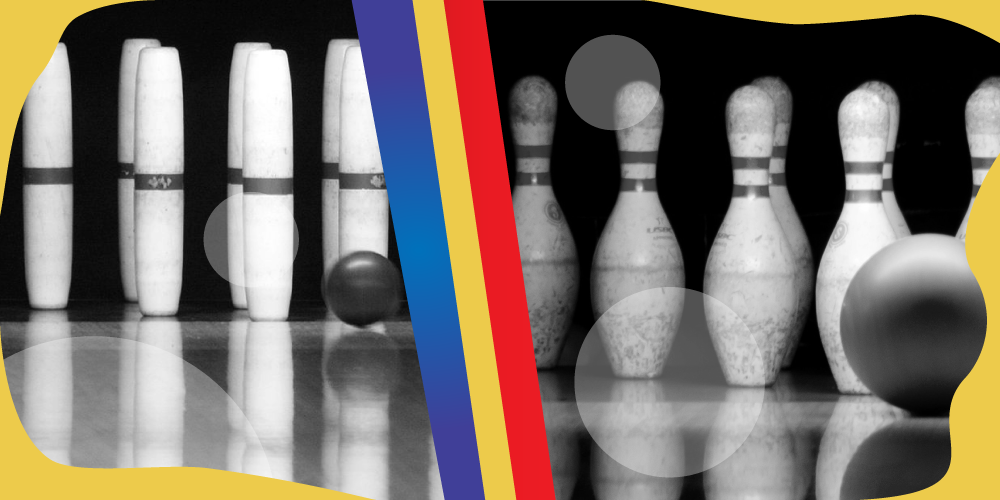Introduction
Candlepin bowling is a unique, old-style form of bowling that uses small, fingerless balls and thin, candle-shaped pins. Unlike ten-pin, players get three rolls per frame and knocked-down pins (called “deadwood”) remain on the lane until the frame ends a rule that changes strategy and shot selection dramatically. Candlepin is famous for being both deceptively difficult and highly strategic: the ball is lighter and smaller, so success depends less on brute strength and more on precision, timing, and using fallen pins to your advantage. Because of those features, candlepin is accessible to a broad range of ages and physical abilities, and it has a strong community feel where timing and finesse often beat power.
Origins and history how candlepin began
Candlepin traces its roots to Worcester, Massachusetts in the late 1800s. Early bowling-hall owners and enthusiasts experimented with smaller balls and slimmer pins to create a fresh variation. Over time, the game standardized pin and ball sizes were fixed, and organizations were formed to oversee fair play and promote leagues. The introduction of automatic pinsetters in the mid-20th century further popularized candlepin, adapting technology to this unique game. Today, candlepin remains a cherished New England tradition with documented high scores, thriving community tournaments, and a loyal base of players who proudly carry on its history.
How it’s played rules made simple
A candlepin game has ten frames. Each frame allows up to three deliveries using a small, no-finger-hole ball roughly 4.5 inches in diameter. The ten slim, candle-shaped pins are arranged in the same triangular formation as in ten-pin. Unlike other forms of bowling, fallen pins remain on the lane as “deadwood” and can influence the outcome of later shots in the same frame. Scoring follows familiar marks: a strike is all ten pins down on the first roll, a spare is clearing them in two or three rolls, and bonus points are added accordingly. This combination of small ball size, extra roll, and deadwood strategy makes candlepin a fascinating challenge.
Candlepin vs. ten-pin (and duckpin)
Candlepin differs from ten-pin in several important ways. The ball is much smaller and has no finger holes, so it is gripped and thrown differently. Players receive three balls per frame instead of two, and fallen pins are never cleared until the frame ends. Those “deadwood” pins add a tactical layer, as they can be used to help knock over remaining pins. The slim pin design and lighter ball make strikes far rarer than in ten-pin, which is why top candlepin scores are much lower. Compared with duckpin, another small-ball variation, candlepin features slightly larger balls and taller, thinner pins. Each of these distinctions gives candlepin its own unique flavor, demanding more finesse and strategy.
Improve your candlepin game
Candlepin is a game of accuracy rather than power. A consistent delivery is crucial because the smaller balls magnify small mistakes. Practice your release and work on controlling your wrist to achieve a steady roll. Spare shooting is a big part of success; learning how to use fallen pins effectively can help you convert tough setups. Sometimes it’s smarter to aim for a certain pin that can cause others to topple with the right angle. Watching experienced players also helps, since local leagues often have techniques and traditions passed down through generations. The key is patience, precision, and creative use of deadwood.
Why New England loves candlepin
Candlepin is more than just a sport in New England; it’s a community tradition. Its accessibility light balls, simple equipment, and a focus on finesse made it popular with families, schools, and neighborhood leagues for generations. Local TV shows once featured candlepin matches, and some towns still host annual tournaments that are beloved community events. Because the game originated locally and remained regionally concentrated, it became an important piece of cultural identity in New England. Even as ten-pin bowling became the global standard, candlepin held on in its strongholds thanks to its nostalgic charm and the loyalty of players who see it as part of their heritage.
Conclusion
Candlepin bowling is a charming and challenging regional sport that rewards technique, patience, and community spirit. Its unique equipment and rules create a style of play unlike anything most ten-pin bowlers experience. Whether you’re a traveler curious to try something new in New England or a local looking to join a league, candlepin offers a fun but demanding game. Small balls, slim pins, and big character that’s candlepin in a nutshell.
FAQs
Q: Where can I play candlepin?
A: Candlepin bowling lanes are mainly found in New England states like Massachusetts, New Hampshire, and Maine, as well as parts of Canada’s Maritime provinces.
Q: Is candlepin harder than ten-pin?
A: Many players consider it harder because strikes are rare, the balls are lighter, and deadwood stays on the lane. It requires more accuracy and strategy than raw strength.
Q: What equipment do I need to start?
A: You don’t need to buy much; most candlepin alleys provide the balls. You’ll just need bowling shoes, which can be rented or purchased if you play often.
Q: Are there official rules or organizations?
A: Yes. Candlepin has an established rule set and governing bodies that oversee official leagues and tournaments to maintain fairness and consistency.









